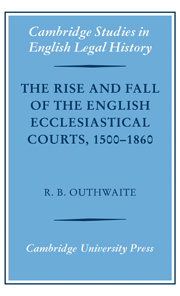Book contents
- Frontmatter
- Contents
- Foreword by R. H. Helmholz
- Preface
- Table of parliamentary statutes
- List of abbreviations
- 1 The ecclesiastical courts: structures and procedures
- 2 The business of the courts, 1500–1640
- 3 Tithe causes
- 4 Wills and testamentary causes
- 5 Defamation suits
- 6 Marital suits and marriage licences
- 7 Office causes
- 8 The roots of expansion and critical voices
- 9 Charting decline, 1640–1830
- 10 Explaining decline
- 11 The bills of 1733–1734
- 12 Snips and repairs: small steps to reform, 1753–1813
- 13 Royal commissions and early fruits, 1815–1832
- 14 Reform frustrated
- 15 Reforms thick and fast, 1854–1860
- Select bibliography
- Index
9 - Charting decline, 1640–1830
Published online by Cambridge University Press: 21 January 2010
- Frontmatter
- Contents
- Foreword by R. H. Helmholz
- Preface
- Table of parliamentary statutes
- List of abbreviations
- 1 The ecclesiastical courts: structures and procedures
- 2 The business of the courts, 1500–1640
- 3 Tithe causes
- 4 Wills and testamentary causes
- 5 Defamation suits
- 6 Marital suits and marriage licences
- 7 Office causes
- 8 The roots of expansion and critical voices
- 9 Charting decline, 1640–1830
- 10 Explaining decline
- 11 The bills of 1733–1734
- 12 Snips and repairs: small steps to reform, 1753–1813
- 13 Royal commissions and early fruits, 1815–1832
- 14 Reform frustrated
- 15 Reforms thick and fast, 1854–1860
- Select bibliography
- Index
Summary
The opening of the Long Parliament in November 1640 witnessed considerable hostility directed at Archbishop Laud and the Arminian policies associated with him. Five weeks later, in mid-December, the Root and Branch petition was presented to the Commons and this helped to focus hostility towards the structure of the English church and the role of bishops within it, a redirection that was encouraged by a welter of county petitions calling for the abolition of episcopacy. In 1641 the High Commission was abolished and the ecclesiastical courts were stripped of their corrective powers; in 1642 bishops were excluded from the House of Lords; in 1643 episcopacy was abolished altogether, along with cathedral deans and chapters. In 1645 Archbishop Laud was executed, and in the following year episcopal estates were put up for sale along with the estates that had belonged to deans and chapters.
It is hardly surprising to find that the business of the church courts withered in the face of these repeated assaults. The church courts effectively fell with the bishops. Office causes in the consistory court of Gloucester ended in 1641, and the last tithe and defamation suits were heard there in December 1642. Probate and testamentary business appears, however, to have continued there for some years thereafter, even surviving the formal abolition of the courts by the Long Parliament in October 1646. Similar patterns have been found in other ecclesiastical jurisdictions, such as those of the courts of Canterbury.
- Type
- Chapter
- Information
- Publisher: Cambridge University PressPrint publication year: 2007
- 1
- Cited by

